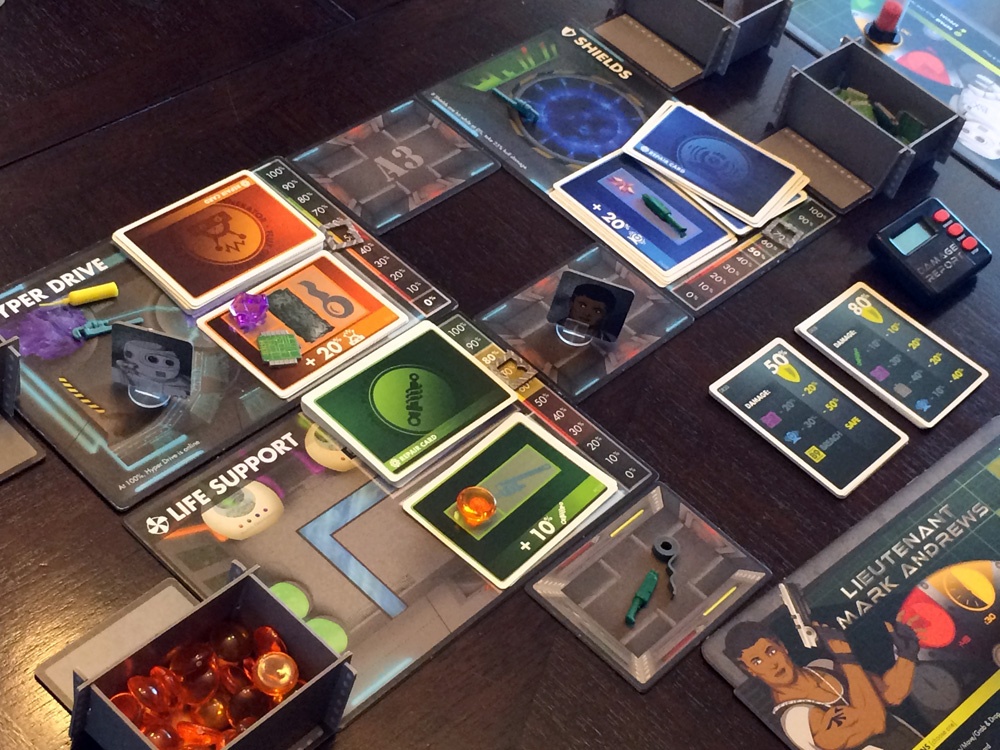 One of my favorite video games of all-time is a game called FTL. It’s a strategy & action game where you control a starship crew that is continually running into the trials and tribulations that accompany space travel, such as enemy ships, space junk, supernovas and boarding parties. It’s one of the most addictive (and difficult) games I have ever played, and it has rapidly become a cult favorite amongst the videogamerati.
One of my favorite video games of all-time is a game called FTL. It’s a strategy & action game where you control a starship crew that is continually running into the trials and tribulations that accompany space travel, such as enemy ships, space junk, supernovas and boarding parties. It’s one of the most addictive (and difficult) games I have ever played, and it has rapidly become a cult favorite amongst the videogamerati.
Damage Report, by Break from Reality Games, has the feel of FTL but in board game form. You take the role of crew members of a starship, faced with survival in the vast emptiness and loneliness of space. Does Damage Report set a course for exciting game play and a good time? Keep reading to find out!
Damage Report is a sci-fi real-time cooperative game for 2-6 players that plays between 45-60 minutes. Damage Report plays best with 3-5 players.
Game Overview
In Damage Report, you take the role of a starship crew facing a scenario that threatens the ship, such as alien first contact, warping too close to a sun, or an asteroid collision. Each player controls a character with unique abilities that races around the ship collecting items and resources in order to repair systems. The players all take their moves simultaneously, with time between actions measured with sand timers and based on the game state. Every three minutes, a timer goes off as more damage is done to the ship, giving the players the challenge of splitting their focus between achieving their objective and repairing the damage to their ship. Each scenario provides specific win and loss conditions that take effect as soon as they are reached. Winning players can keep a record of their winning times and compare them to previously run scenarios.
Components

As part of the setup of the game, the players are required to construct the ship using various modules that come into play (Shields, Medical Bay, Life Support, etc.), along with the repositories of the various resources that are needed to conduct repairs as damage gets applied to the ship. When finished, the board setup really gives you the feel that you are living, working and moving on a spaceship. Because of the frenetic and fast-paced nature of the game, the cardboard and cards are reasonably sturdy and stand up well to hard playing.
Sadly, as sturdy as the main board, player boards and cards are, the sand timers, digital timer and other components (resource tokens, player pawns) are the opposite. In our first game, we had a sand timer chip and crack after 2 plays, and another sand timer would function intermittently. While wanting to keep production costs down is understandable, having quality components related to the core mechanic of the game should be a priority.
Another point worth mentioning is the artwork in this game. As someone who has little artistic talent, I appreciate the difficulty (and expense) in designing and developing quality art for a game. That said, it would have made for a better game experience if the artwork created more immersion in the game world.
How to Play
The game begins by selecting or creating a scenario for your crew to attempt, based on the number of players in the game. After setting up the ship based on the scenario requirements, all players are read the game end conditions with win conditions (i.e. Hyperdrive repaired to 100%) and loss conditions (i.e. Life Support or Hull reach 0% or time elapses) clearly explained and understood. Each player selects a character, each with a different special power (i.e. repairing faster, larger carrying capacity, repairing easier, etc.), which allows players to customize their party when facing a particular scenario.

The core mechanic in the game is action timing. All players take actions simultaneously, with timing between actions based on flipping a 15-second sand timer. Each player board has a red, yellow and green circle for sand timer placement, and when the sand timer is flipped onto the green circle, a player can take their action. When the sand timer runs out after their action, they flip the sand timer onto the color associated with the current repair level of Life Support, then move through the circles until they reach green again. Depending on the level of repair in life support, time between actions can be either in 15-second, 30-second or 45-second intervals, so keeping Life Support at high levels of repair is an early priority.
Repairing is done by gathering resources (crystals, energy, tech supplies) and tools (blowtorches, wrenches) from different areas of the ship to modules that need repair, based on an upturned card that details the resources needed and the amount of repair that is done when the job is completed. Damage Report cards go off every three minutes, which cause automatic damage to various systems, based on the individual card.
On a player’s turn, they can take one of four actions:
Relay: Grab and drop resources in their module, move to an adjacent module, then grab and drop resources again.
Inspect: Turn over the next repair card in on a damaged module to see what resources need to be picked up and delivered to complete repairs.
Repair: Move an item from your inventory to the repair card in order to complete repairs.
Special Action: Some modules allow characters to take special actions. For instance, a character in the Teleporter can transport items, resources and people across the ship instantly, depending on the level of repair of the Teleporter module.
Players have to work together in order to plan and take their actions to repair the systems that need repairing, while dealing with the random effects of Damage Report cards and the looming time cap that is on each scenario.

Game Experience
Damage Report, like other real-time games, provides players with a frenetic and sometimes chaotic experience of reacting to changing game effects in real time. When played, it was common for orders to be shouted between players and small disagreements as to the best course of action to break out. It was especially noticeable when the Damage Report timer would go off every three minutes, even though it seemed like a much shorter time had passed. In this regard, Damage Report does a solid job in the immersion and feel of the game.
That said, if you do not do as well of a job in attacking the scenario, there is a very good chance that your Life Support level will dip into the red, which means that each player has to wait 45 seconds to take an action. This is far too much downtime in a real-time game, in my opinion. In addition, we felt that being able to move to one adjacent module was slowing the game down as well, but this was an easy fix with some quick house-ruling about how many modules a player could move.
It needs to be understood going in to Damage Report that it is, at the core, a pick-up and deliver game, which can be very repetitive at times and a turn-off for some gamers. When combined with lagging downtime due to the action selection mechanic, there were some points where game play literally ground to a halt for some of our players. It did not happen often, but often enough where I was concerned about the repetitive nature of the game.

We are fans of player characters with unique powers, and the characters in the game had relatively balanced powers that lend to their particular role in the game. Players who want to focus on doing all the repairs can played the Engineer (do a double repair) or Scientist (substitute resources when making repairs) while players who want to do the heavy lifting and moving can take the Lieutenant (bigger carrying capacity) or the Robot (never gets injured). There were no PCs that were amazingly out of balance, and they contributed well to the flavor of the game.
Like some other games with a real-time aspect, this game might run more smoothly if one player serves as the “Captain” of the game, handling Damage Reports and directing the game play rather than trying to have players do so in their downtime, since players are focused on their own individual goals and not always aware of the entire board state.
Refreshing aspect to the rules are definite ways of scaling each scenario to either add or decrease the difficulty level of the game. This is helpful for groups of players who are either starting out with a real-time game like this and getting beaten soundly, or for play groups who are simply buzz-sawing through the game with little to no effort. While not appropriate for all games, we felt that this addition to the rulebook was great for people who might get turned off due to the relative ease or difficulty of the game.
Final Thoughts
Damage Report is a decent game for fans of the science-fiction genre and who enjoy real-time cooperative games. Once you understand the core mechanics, you can jump right into one of the early scenarios, but we recommend that you select one player as your “captain”; to facilitate the game and be completely proficient in the rules for the most success.
While the potential is there for a good game, rules modifications and scaling are pretty much required to have avoid repetitive actions and too much down-time. Even though the artwork is mediocre at best, the modular design of the game board does an alright job of making you feel like you are piloting a spaceship and dealing with crises as they arise. If you are a die had fan of real time games, then Damage Report might be worth checking out. But for us, it would need too many “house rules” to make it to our gaming table very often.
If you are interested in getting a copy for yourself, you can get it for $50.
Final Score: 2.5 Stars – An game that needs some modifications and scaling to avoid repetitive game play and excessive downtime. It has potential if the expansions can repair some of the issues.
 Hits
Hits
• Simultaneous action selection
• Sturdy game board components
• Fun theme and concept
• Rules for scaling difficulty level
• Unique and balanced character powers
Misses
• Game state can lead to lagging downtime
• Artwork could be improved
• Play improves with a Captain/GM
• Sand timers are low-quality and can easily malfunction and break
• Some rules tweaking needed to improve gameplay






















I agree with you Alex and think you were too kind – 2 stars at the most. It seems like a game that wasn’t playtested enough. It really needs something to make it less repetitive and more engaging.